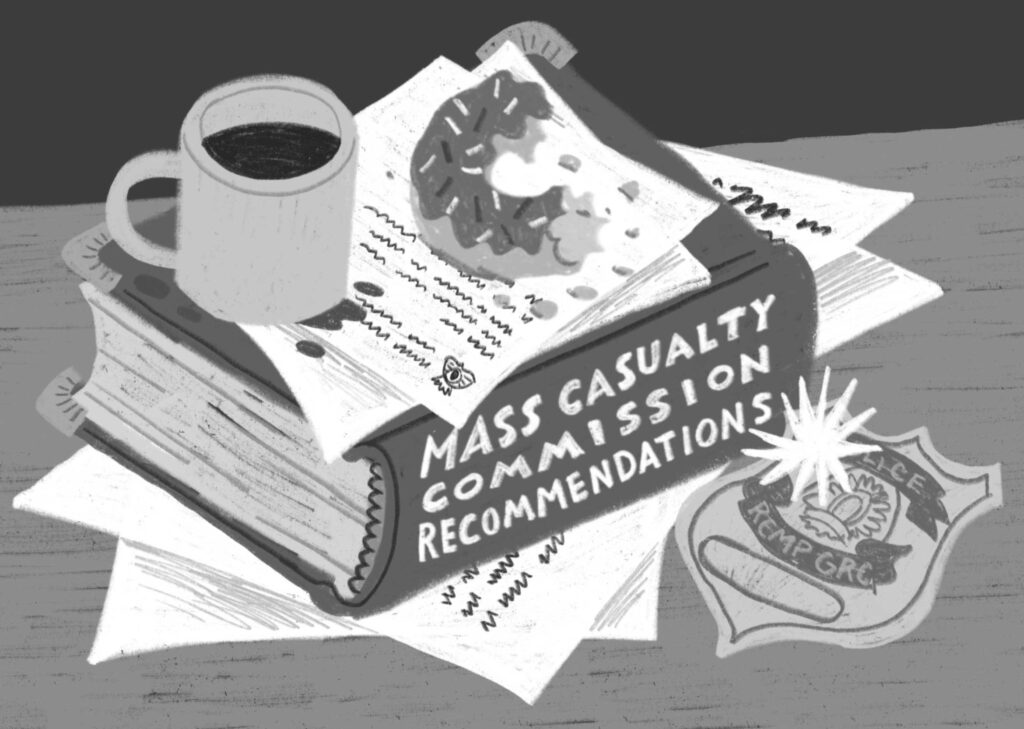The tiny seaside community of Portapique, Nova Scotia, now bears an infamous name. In April 2020, amid the initial COVID‑19 lockdown, a rage-filled, crazed gunman killed twenty-two people, starting in that village and expanding his scope to surrounding communities over some thirteen hours. The deadliest mass shooting in Canadian history attracted fleeting national media attention, before the cameras moved on to other events. But the nightmare prompted an independent public inquiry, examining mostly why the local Royal Canadian Mounted Police detachment failed to stop the carnage, kept the public more or less in the dark, and resisted full transparency.
Several renowned critics of the agency jumped on the mass murder as yet another example of its crumbling reputation and sheer incompetence. One of the country’s most tenacious investigative reporters, Paul Palango, came out of retirement with a mission to expose the latest episode in an ongoing miscarriage of justice. Now living on Nova Scotia’s South Shore, Palango seemed to take on everyone, including the local press for its tendency to parrot RCMP media releases rather than dig deeper. Shunned by many news outlets, he nonetheless found a ready audience on Halifax talk radio and in the pages of Nova Scotia Frank.

Without the political will, necessary reforms seem unlikely.
Alexander MacAskill
Published in 2022, before the Mass Casualty Commission’s final report, Palango’s bulging and best-selling 22 Murders: Investigating the Massacres, Cover‑up and Obstacles to Justice in Nova Scotia took aim at the RCMP’s glaring failures, curtain of protective silence, and dismissive attitude toward the victims’ families. As a veteran of previous policing scandals, Palango was single-minded in his pursuit of the facts, exploring any sign of possible complicity in abetting the murderer and any attempt at a whitewashing to stem further reputational damage. Now Dean Beeby offers Mass Murder, Police Mayhem, in which the former Canadian Press reporter tries to sort out the complex events while wading through the commission’s voluminous research and mostly indigestible findings. The result is a well-written précis of the full report, with little embroidery.
As Beeby distills the commission’s work, he tries to correct the historical record by discounting some of the more contentious claims made by Palango. Beeby, for example, presents the perpetrator — the fifty-one-year-old denturist Gabriel Wortman — as more of an alcohol- and drug-fuelled abuser of women than a wily criminal mind and pistol-toting bully. While Palango focused on Wortman’s close relationships with officers, his sources of funds, and his apparent immunity from being charged or arrested for reported assaults and gun-running, Beeby adopts the commission’s approach by delving far more deeply into the long-term abuse of his partner, Lisa Banfield. Beeby’s analysis demonstrates that Banfield was Wortman’s first victim rather than an unwilling accomplice.
Beeby also lays out how the Mounties bungled their surveillance of Wortman and their search for him on April 18 and 19. He calls out the crudeness of the RCMP’s training, preparedness, and emergency-alert protocols, and he describes the pseudoscience that informed the force’s “psychological autopsy” of the killer and labelling of Wortman as an “injustice collector.” Beeby is perhaps less convincing when he tries to account for the mayhem and confusion surrounding the immediate search, characterizing it as the result of numerous accidents, mistakes, and oversights.
Like Palango, Beeby also recounts Wortman’s frighteningly cruel streak and weird fixation with RCMP uniforms, weapons, and vehicles, but he offers no plausible explanation for how Wortman succeeded in currying favour with local officers and why he remained untouched before he went on his rampage.
Beeby’s most meaningful achievement in Mass Murder, Police Mayhem is to translate into a more comprehensible format the imposing Mass Casualty Commission report, Turning the Tide Together, released on March 30, 2023. He provides an accurate and more readable summary of the critical events associated with the killing spree. Throughout, Beeby presents the police response as a sad lesson in how not to conduct a manhunt, miss clues, retreat behind a cloak of secrecy, and deny mistakes.
Most surprising in this new book, though mirroring the official report, is Beeby’s relatively light treatment of the RCMP’s totally inept communications strategy. “The RCMP’s public and media communications at the outset of the Portapique crisis,” he writes, “were minimal, delayed and misleading.” That’s a serious understatement. In fact, the approach was, in the crude vernacular, a complete shit show.
At a hastily called news conference on April 19, Chief Superintendent Chris Leather and Lee Bergerman, the RCMP’s commanding officer in Nova Scotia, attempted to respond to the initial murders. Anyone who watched that day could sense the complete disarray: the “deer in the headlights” look, the incoherent messaging, the inaccurate death count, and the fumbling for answers. More than a dozen lay dead at that point, and the RCMP addressed almost exclusively the fate of a single victim, Heidi Stevenson, an RCMP constable who fell in the line of duty.
Leather, a risen-through-the-ranks officer who cut his teeth with the York Regional Police in Ontario, is barely mentioned in Beeby’s book. (Palango, for his part, aptly quoted those who knew him as the “Sheriff of Stouffville.”) Nor is there any scrutiny of the RCMP’s attempt at damage control, after Leather was sidelined as an official spokesperson by the smooth-talking, impeccably diplomatic Superintendent Darren Campbell. (In what Palango described as the “cult-like atmosphere of the RCMP,” Campbell was known as “the anointed keeper of the Kool‑Aid dispenser.”)
How did Gabriel Wortman avoid detection for years and go on to commit so many murders? Even after reading Beeby’s book and numerous excerpts from the commission’s report, it remains difficult to answer that fundamental question. The denturist’s regular abuse of his partner was an open secret in Portapique, as were his fake RCMP patrol car and his cache of unregistered weapons. Why did local Mounties look the other way or fail to act on serious accusations? One woman, Brenda Forbes, was so frightened by her neighbour that she moved to Ontario. She had raised numerous concerns, but nothing happened. Then Wortman threatened her, saying, “I’m going to take you out.”
“I lost a lot of respect for the police,” Forbes later testified, when asked why she stopped making reports. “I didn’t think anything would ever get done.” Those words cut to the heart of the matter: a loss of faith in the RCMP and in the trustworthiness of its officers.
In its report, the Mass Casualty Commission offered 130 recommendations. Following the commission’s numbering system, Beeby lists each one, alongside simple, direct summaries. Unfortunately, there seems to be a lack of priority among the recommendations, which jump all over the place. One of them calls for a standard definition of “mass casualty incidents” and for an established framework for tracking such incidents. Over a dozen of the others adopt a “public health approach” (vaguely defined in the second recommendation) that’s aimed at preventing and responding to future mass casualty events. Many of the overlapping recommendations reaffirm various “trauma‑informed” suggestions gleaned from expert testimony. Gender-based violence receives considerable attention, as does intimate partner violence. This perspective speaks to the influence of Banfield’s experience — and is at odds with Palango’s conclusions.
To some extent, the commission muddied the waters by failing to distinguish between major structural reforms and narrower, more technocratic bureaucratic fixes. It’s stunning to read the ninety-fifth recommendation, for example, which calls upon the RCMP to finally act upon three key recommendations made by a previous task force — back in 2007. Giving senior staff closest to a police activity the authority to make timely decisions, delegating more authority to provincial divisions and contracted parties, and providing a written mandate defining the roles and responsibilities of headquarters in relation to contracted divisions: these all sound like common sense. In the fossilized world of the RCMP, however, the task force’s call for a “radical overhaul” has been resisted and feared as a precursor to breaking up the national force.
Two of the commission’s other recommendations — on “modernizing police education and research” and “management culture”— do get to the root of the systemic dysfunction that afflicts the force and limits its effectiveness in responding to various crises, from mass casualty events and sexual harassment revelations to leadership improprieties. Indeed, dismantling the “Depot model of RCMP training,” a twenty-six-week program based in Regina, would be a step forward. So would developing educational partnerships with colleges and universities. But revamping the force’s “unhealthy” management culture and promotion structure will be a harder nut to crack, because, in many eyes, implementing such reform will be tantamount to waging war on those who serve.
Ultimately, Beeby’s book succeeds in its principal goal: making the commission’s lengthy report accessible to a wider public — especially to the policy makers, police authorities, and public health officials charged with acting upon its findings. But without political will, including a public safety minister in Ottawa with a clear mandate for reform, the necessary structural changes will not likely materialize.
Paul W. Bennett is an author, education columnist, and regular guest commentator on talk radio. He lives in Halifax.

